The City of Salerno
About Salerno: Salerno was founded in the pre-Roman age, became a Roman colony since 197 B.C., a Langobard princedom since 847 A.D., and a Norman one since 1076. It was part of the Kingdom of the Two Sicilies.

The architecture of Salerno has greatly been influenced by Langobard domination, while Naples is mostly characterized by Byzantine art. Langobard people, which came from Scandinavia, arrived in Italy in the sixth century. Their first settlement was in the Northern part of Italy, in fact, Pavia was their capital. During the successive centuries, they moved South, so the dukedom of Benevento was founded and Salerno became part of it.
Nowadays, Arechi Castle overlooks Salerno and represents one of the most remarkable remains of Langobard age. It covered a key role in the defence system of the town, in fact, it was the starting point of the surrounding walls that protected the town up to the seaside.
In Medieval ages, Salerno welcomed some towering scientists. In fact, in the ninth century the “Schola Salernitana” was established. It has been the first medical school of the world, and in which Christian, Jewish and Arabic doctors and researchers worked together in Salerno. Only the successive foundation of the University of Naples undermined its academic supremacy, but Salerno Medical School is also remembered to be the first one that accepted women as students and lecturers.
Salerno covered an important role also in the twentieth century, especially during the Second World War, being the capital of Italy for five months, when Allies disembarked in the South of Italy.
Around Salerno: If you are interested in more detailed touristic information we suggest to visit the Live Salerno Website. Some of the most popular areas around Salerno can also be found below:
Amalfi Coast
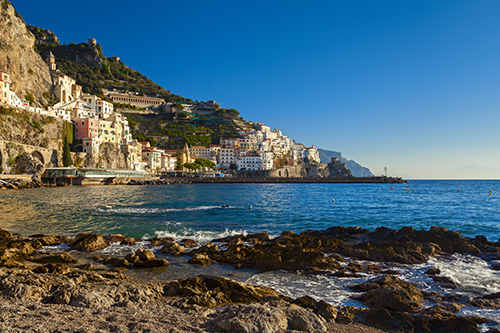 |
The Amalfi Coast is one of the most enchanting coastlines in Europe, for the spectacular landscape and historic heritage of the place. The vegetable patches and the gardens are all contained in terraces, where the products, like lemons, are cultivated from centuries. The nature of Amalfi coastline has made very difficult and interesting the construction of the main road (named Statale 163) that connects all the villages of the coast. This incredible road was built around 1840 and completed in 1852, and it wings around the mountains, on cliffs varying from 50ft to 400ft above the sea, offering each corner a breathtaking sea view. Discover the beauty of the hiking trails along the Amalfi Coast: the Path of the Gods from Praiano to Positano or from Praiano to Agerola, the Path of Agaves in bloom, the Path towards the Monastery of Santa Maria a Castro, the paths that from the heart of Praiano lead to the suggestive beaches of this beautiful location. There are numerous hiking paths on the splendid Amalfi Coast, starting from the Coast to reach the Lattari Mountains, giving unique sceneries and unforgettable views to the visitors and the nature lovers. |
Positano
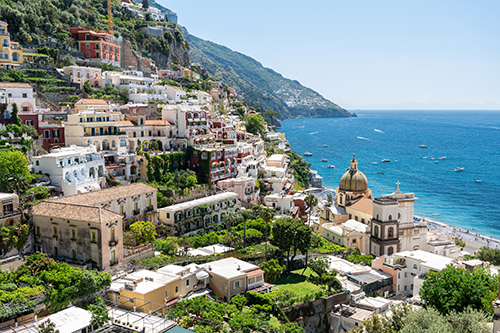 |
One of the most gorgeous pearl of the Amalfi Coast, worldwide famous for its beauty. Positano is synonymous of summer fashion. Its boutiques made every summer thousands of dresses in cotton, silk and linen. The fantasy and the geniality of their creations, whose colours are very simple like the green emerald, the white and the yellow, always suggest the summer fashion. More Information: https://www.positano.com/en/s/positano-3 |
Ravello
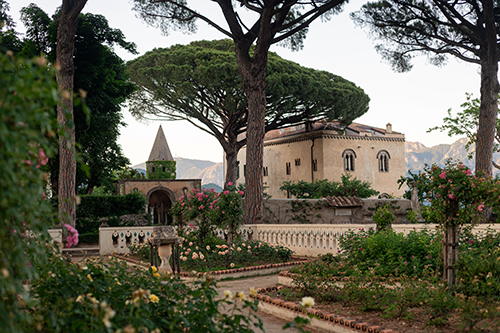 |
Ravello is located about 5 km from Amalfi; up on the mountains, overlooking the coast from Maiori to Amalfi. The Villa Rufolo, from XII century, erected by the Rufolo's family and the Villa Cimbrone, are two sites not to be missed for their splendour and their internal decorations. Both these Villas have an amazingly beautiful garden that, if it is even possible, enhances the Villas even more. From Villa Cimbrone, you can admire one of the most divine panoramic views of Italy, along all the Amalfi Coast, and on some days, up to the Coast Cilentana. |
Paestum Archaeological Park
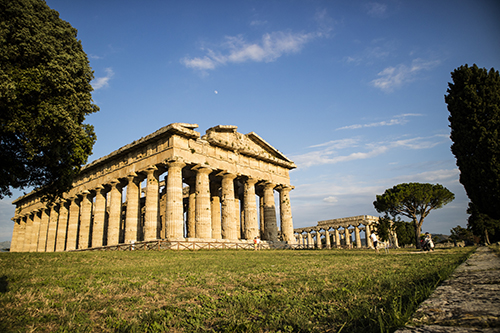 |
The Archaeological Park of Paestum is a UNESCO World Heritage Site. Paestum was one of the major ancient Greek cities on the coast of the Tyrrhenian Sea in Magna Graecia. Three magnificent Doric temples overlook the whole park. A Museum preserves stunning archaeological finds, such as the Tomb of the Diver. Paestum was a major ancient Greek city on the coast of the Tyrrhenian Sea in Magna Graecia. After its foundation by Greek colonists under the name of Poseidonia, it was eventually conquered by the Lucanians and later the Romans. The Lucanians renamed it to Paistos and the Romans gave the city its current name. The ruins of Paestum are notable for their three ancient Greek temples which are in a very good state of preservation. Today the remains of the city are found in the modern fraction of the same name, which is part of the community of Capaccio in the Province of Salerno. |
Path of Gods
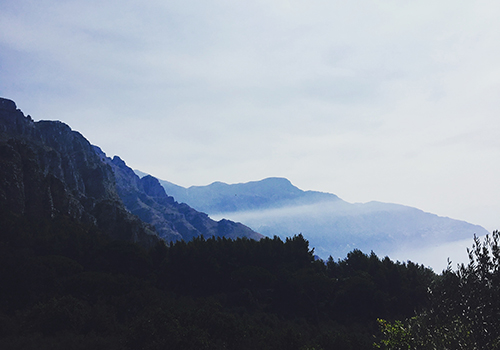 |
The Amalfi Coast is famous all over the world for its natural beauty, so we can't miss the Path of the Gods as the first among the top ten things to do in the Amalfi Coast. The Path of the Gods, from where on the clearest days you can admire in all its glory this corner of paradise, day after day, enchants several tourists and visitors. It is a naturalistic path on the Lattari mountains that runs along the entire coastline for 7 km. In the fraction of Positano, Nocelle, it is perhaps the most interesting part of the Path of the Gods. In fact, it is precisely here that the landscape becomes suggestive due to the alternation of pine forests, caves to explore and especially spectacular glimpses of the Amalfi Coast. |
Naples
 |
In the shadow, the Vesuvius tourism roots run deep: on the imprints of great greek columns refined aristocrats and Roman emperors built their sumptuous villas and oasis all along the shoreline of the Gulf. It is not a coincidence that at the beginning of this third millennium the peculiar magic of this civilisation continues to generate new sources of amazement: the recovery of age-old monuments and traditions – folklore, gastronomy, genuine cultivation – that were thought irreparably lost, events and shows worthy of the great international circuit, new fodder for artistic and scientific research. Naples’ artistic treasures to visit are countless; the old city centre, world patrimony protected by Unesco; the buildings, the churches, the catacombs and the underground paths, the Archeological Museum; the places of Medieval and Renaissance power around the Castel Nuovo and Palazzo Reale; the unforgettable seafront, from Castel dell’Ovo to Posillipo. The Vomero hill area proposes museum collections among the most important in the world, in restored locations that have been set up in an exemplary way: Capodimonte’s Palazzo Reale and the Certosa of San Martino. |
Capri
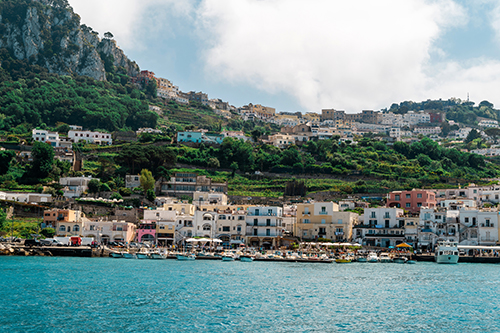 |
Luxuriant, extraordinary, and such a mild climate. Capri is a Mediterranean island of calcareous origin that has been visited over the centuries by intellectuals, artists and writers, all enthralled by its magical beauty. A mix of history, nature, worldliness, culture and events that daily blend together and bring the Legend of Capri to life; a legend that sees no comparison anywhere in the world. Although the majority of holidaymakers staying on Capri wouldn't dream of leaving this paradisiacal island, not even for a minute, those lucky enough to be here for more than a week or two might well be tempted to make the most of its strategic location in the Bay of Naples and to use it as luxurious base from which to visit the tourist attractions on the neighboring islands and on the mainland. Throughout the year, regular ferry and hydrofoil crossings transport passengers boarding at Capri to the nearby ports of Naples and Sorrento. In the summer months, ferry connections are also available to and from the Amalfi Coast. Those who have always fancied sailing the seas in authentic Capri style can rent a boat, with or without skipper, in the harbour of Marina Grande. More Information: www.capri.net |
Ischia
 |
Ischia is a volcanic island in the Tyrrhenian, at the northern end of the Gulf of Naples. It is almost entirely mountainous, with the highest peak being Mount Epomeo at 788 meters. The island has a population of over 60,000 people. The community areas in Ischia include ischia Porto (the main Comune of the island), Barano, Casamicciola, Forio, Lacco Ameno and Serrara Fontana. Ischia is a rare beauty and wellness legacy, an island that celebrates life. 2700 years of history, 103 thermal wellness springs and the largest of the Neapolitan islands, about 30 km from Naples, measuring 10 km from east to west and 7 km from north to south, with 34 km of shoreline. Its highest peak is Mount Epomeo (787 m.). The climate is mild all year round. Throughout Italy and the rest of the world, Ischia is very high on the list of places for its capacity to accommodate tourist requirements and for its variety of environments and natural beauties whose harmonic complexity has a particular attraction and charm for the tourist, who, nearly always, return to island to recover the strength of their bodies and spirits. More Information: www.ischia.it |
Pompeii
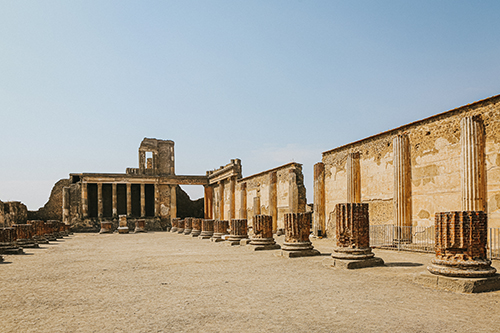 |
Ancient pagan town, buried by about six meters of ash and lapilli following an eruption of Vesuvius, which took place in August 79 AD where many people were dead. In the sixteenth century, it was discovered almost by chance during the construction of an aqueduct and as a proof of this, a plaque has been placed near the Door Nocera. By decree of 1997 Pompeii was included among the sites that are considered World Heritage by UNESCO. The Committee has decided to enter this area on the basis of cultural criteria considering that the extraordinary findings in the city of Pompeii and neighbouring cities, buried by the eruption of Vesuvius in 79 d.C., constitute a complete and living testimony of society and daily life in a moment of the past and cannot find their equivalent anywhere in the world. |